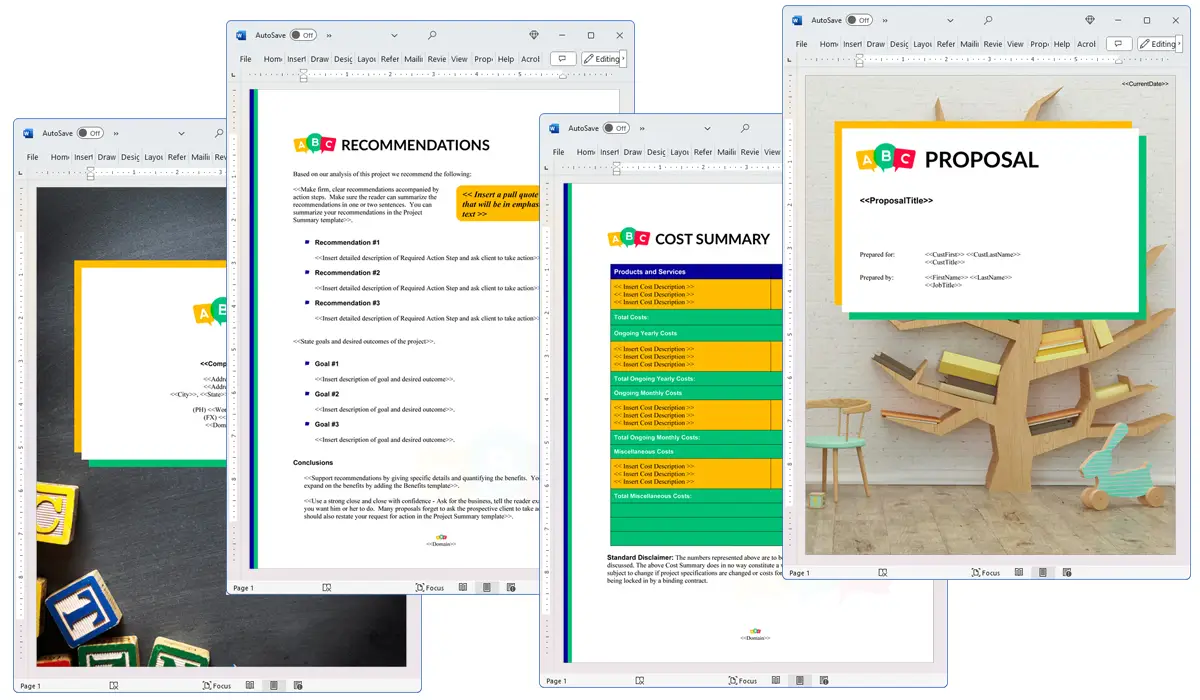What is the Literature Review chapter used for?
Proposal Kit Professional Bundle adds more design themes, all six Contract Packs,
a project management library, and Expert Edition software.

Illustration of Proposal Pack Children #5
We include this Literature Review chapter template in every Proposal Pack, along with thousands more. You assemble this chapter with others in various combinations to create custom-tailored business proposals, plans, reports, and other documents. Proposal Packs apply custom visual designs to the templates, giving the final documents a consistent professional finish.
 DOWNLOADABLE, ONE-TIME COST, NO SUBSCRIPTION FEES
DOWNLOADABLE, ONE-TIME COST, NO SUBSCRIPTION FEES
Overview of the Literature Review Chapter
In the field of business proposals, the Literature Review chapter holds a significant place. This chapter is integral in establishing a thorough understanding of the existing knowledge related to the subject matter of the proposal. By incorporating a Literature Review, the proposal writer demonstrates a comprehensive grasp of the field, outlines how previous research aligns with the current project, and identifies the unique contribution that the proposed work intends to make. This chapter is especially crucial in proposals that aim to secure funding or approval for research-oriented projects.
How is the Literature Review Chapter Used?
The Literature Review chapter is used to support the proposal's main objectives by showcasing the depth of existing studies and the gaps your proposal aims to fill. It provides an important analysis of what has been previously explored and highlights the importance of the new investigation by contrasting it with existing literature. This chapter helps in persuading stakeholders of the relevance and necessity of the proposed project. Furthermore, it sets a solid foundation for justifying the research methodology and potential impact of the findings.
What is Included in the Literature Review Chapter?
Typically, the Literature Review chapter includes several key elements:
- Introduction to the Topic: Briefly introduces the subject that the proposal addresses.
- Summary of Existing Research: Discusses major works and findings relevant to the topic.
- Critical Analysis: Evaluates the strengths and weaknesses of the existing research.
- Identification of Gaps: Highlights the areas that have not been addressed fully or areas where conflicting findings suggest further investigation is needed.
- Connection to Current Proposal: Explicitly links the reviewed literature to the proposed research questions and objectives, showing how the proposal is positioned within the broader academic conversation.
Use Case Examples for the Literature Review Chapter
The Literature Review chapter is and applicable across various types of proposals. Here are some specific use cases:
- Environmental Plans: Reviewing prior environmental impact studies to propose a new conservation project.
- Green Initiatives: Summarizing existing green technology research to introduce an innovative sustainable technology.
- Nature Conservation Reports: Collating historical data on species conservation to support new wildlife protection measures.
- Research Proposals: Analyzing previous academic papers to formulate a new scientific hypothesis.
- Science Projects: Evaluating existing experiments and theories to propose a novel research experiment.
- Studies: Reviewing case studies in a particular domain to propose a comprehensive follow-up study.
- Book Proposals: Discussing existing literature on a subject to argue the need for a new perspective or theory in a forthcoming book.
Key Takeaways
- The Literature Review chapter is important for demonstrating comprehensive knowledge of the subject area and situating the new proposal within the sphere of existing research.
- It serves to identify gaps in current knowledge and justify the necessity and relevance of the proposed project.
- This chapter typically includes a summary of existing research, critical analysis, and a clear link between past work and the current proposal.
- It is widely applicable in various fields including environmental studies, research initiatives, scientific explorations, and academic publications.
- A well-crafted Literature Review strengthens the proposal by showing preparedness to contribute meaningfully to the academic or industry-specific discourse.

Illustration of Proposal Pack Industrial #3
 What Our Clients Say
What Our Clients SayPerfect addition to the Proposal Kit Professional to save time while preparing great looking & organized proposals."
 4.7 stars, based on 845 reviews
4.7 stars, based on 845 reviewsRelated Chapters
Samples Using the Literature Review Chapter
Document Layouts Using the Literature Review Chapter

The Literature Review chapter and other chapters are integrated into a Word document as illustrated here in the Proposal Pack Classic #18 design theme. There are hundreds of design themes available, and every design theme includes the Literature Review chapter template.
A proper business proposal will include multiple chapters. This chapter is just one of many you can build into your proposal. We include the complete fill-in-the-blank template in our Proposal Pack template collections. We also include a library of sample proposals illustrating how companies in different industries, both large and small, have written proposals using our Proposal Packs. This template will show you how to write the Literature Review.
We include a chapter library for you to build from based on your needs. All proposals are different and have different needs and goals. Pick the chapters from our collection and organize them as needed for your proposal.
Using the Proposal Pack template library, you can create any business proposal, report, study, plan, or document.
 Ian Lauder has been helping businesses write their proposals and contracts for two decades. Ian is the owner and founder of Proposal Kit, one of the original sources of business proposal and contract software products started in 1997.
Ian Lauder has been helping businesses write their proposals and contracts for two decades. Ian is the owner and founder of Proposal Kit, one of the original sources of business proposal and contract software products started in 1997.By Ian Lauder
 Published by Proposal Kit, Inc.
Published by Proposal Kit, Inc.


 Cart
Cart
 Facebook
Facebook YouTube
YouTube X
X Search Site
Search Site